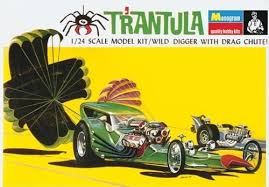-
Posts
38,173 -
Joined
-
Last visited
Content Type
Profiles
Forums
Events
Gallery
Everything posted by Ace-Garageguy
-

Auto quiz 401 - Finished
Ace-Garageguy replied to carsntrucks4you's topic in Real or Model? / Auto ID Quiz
First and only one I've ever seen in the States was on the lot of an out-of-business import car shop back in the late '70s. It had dull faded paint, a raggedy interior, an engine caked with oily grot, and I didn't know what it was at the time (though I did recognize the engine). I managed to track down the owner of a terminally rusty S1 E-type roadster that was also on the lot, and bought it...but when I went back to get the Jag, the mystery car was gone. -

Educate me on Model T speed equipment
Ace-Garageguy replied to Aaronw's topic in General Automotive Talk (Trucks and Cars)
All the Revell kits shown had either the Riley OHV conversion, or a Winfield high-compression flathead. Most had the Riley. The truck and its later derivatives, I believe, had the Winfield. The Ala Kart double kit has another Riley OHV setup. That kit is the daddy of all the subsequent AMT '29 Ford roadster kits, which continued the Riley. The only T there is in the XR6 double kit, which was the daddy of all the subsequent AMT '27 T phaeton kits...which all included the Frontenac DOHC from the double-kit original. -
Yeah, the wheels and tires in the '36 Ford are real beauties, as are the entire lineup of tires. In a way, I feel kinda bad criticizing R2, because their restorations of some older kits, returning the original parts to the box, is just great. Fine with me, and I've bought most of them. But I was just SO disappointed by the top on the '36. I honestly would have bought multiples, as a chopped '36 Ford is absolutely one of my favorite things on the planet, and those new wheels and tires make a nice bonus. But after seeing the newly-tooled roof, I just can't figure out what went wrong. As I mentioned, when the original parts still exist, looked fantastic just as they were, and fit the bodies quite well, HOW and WHY would you not just pull your dimensions DIRECTLY from an original?
-
Another one of these. The Fumin' Fiat/Thunder Charger is about the hardest to come by of the old Revell double-dragster kits, so when one pops up for reasonable money, I usually jump if possible. I think Revell was at the top of their game when these were in production, and though they have a reputation for being "difficult" and "fiddly", in the hands of a careful and skilled modeler, they'll still produce show-stopping models with just a few minor upgrades like plug wires and laced or PE wire wheels. After seeing what a cool model Ray Kurn (cobraman) built from one of these kits, I figured I'd pick one up next time I saw one cheap. Perfect starting point for some crazy LSR thing, or a racing boat. Who knows? And one more cheap T'rantula. Mostly for the cam covers, but it might breed with the thing just above it...
- 38,654 replies
-
- johan
- glue bombs
-
(and 1 more)
Tagged with:
-

Educate me on Model T speed equipment
Ace-Garageguy replied to Aaronw's topic in General Automotive Talk (Trucks and Cars)
Here's the best one-stop info source I know of for all things hot pre-1934 four cylinders. https://www.nwvs.org/index.shtml -

Educate me on Model T speed equipment
Ace-Garageguy replied to Aaronw's topic in General Automotive Talk (Trucks and Cars)
Here's an article from the Society of Automotive Engineers (SAE), dated 1916. https://www.jstor.org/stable/44579439?seq=1#metadata_info_tab_contents In short, magnetos have two main advantages over battery-type ignition systems. 1) Because a mag generates its own power internally as it rotates, the ignition system will continue to function even if the rest of the electrical system fails entirely. This is the reason small airplanes are still equipped with magnetos to this day (almost always having two, for full redundancy). And even with a completely dead battery, or no battery at all, you can start a mag-equipped vehicle by pushing it. 2) Magnetos tend to produce a hotter spark at higher RPM than battery-type systems. This has obvious benefits as far as all-out racing applications go. Unfortunately, because magnetos have points that control the timing, they share some of the shortcomings associated with all point-type ignition systems, one of the most irritating being a tendency for the contacts of the points to "arc" as they open, leading to degradation over time. This is controlled by incorporating a "condenser" or capacitor, but degradation still occurs, and the capacitor is a potential failure point (as it is in a standard battery/coil type system). The points in a mag also depend on a rubbing-block that runs on the internal cam (just like in a distributor). They wear down, leading to changes in ignition timing (as they wear and close the point gap, ignition timing is retarded). Anyone competing with ANY non-electronic-ignition-system equipped vehicle would do well to check and file the points flat and square, and double check the gap and timing prior to every day's run. -

Educate me on Model T speed equipment
Ace-Garageguy replied to Aaronw's topic in General Automotive Talk (Trucks and Cars)
PLUS...A replica Frontenac DOHC top-end, with the head and drive covers cast to look like vintage parts, but with state-of-the-art materials and combustion chamber shape and porting, plus multiple sidedraft SU or Amal carbs, would keep everything looking appropriately vintage, but offer power and reliability in line with today's engines (well, you'll have to tinker with the carbs from time to time). -

Educate me on Model T speed equipment
Ace-Garageguy replied to Aaronw's topic in General Automotive Talk (Trucks and Cars)
People did in fact drive model T automobiles across the country in stock form in the dim recesses of history, so a long distance rally using today's preparation and upgraded materials is certainly feasible. The "hottest" of the T hot-rod parts available in kit form would undoubtedly be the DOHC Frontenac represented in the AMT '27 kits. It's debatable whether this would have given the kind of reliability in 1927 to make it from Paris to Dakar, (EDIT: or Peking) but it's absolutely positively possible to get that from the vintage setup using today's materials for valves, valve springs, timing chain, cam and followers, etc. Headers of course, on whatever you build, and probably multiple carburetion. The famous Vertex magneto became available in the 1930s, and would be a good choice if legal for the class rules. The Riley OHV conversion represented in both AMT and Revell kits (the Revell is the nicer) is a setup for a model-A engine (1928-1931, and available in later models through 1934 IIRC). I don't know right off hand how stringent the race rules are, but a late-model A (referred to many as a "C") engine fitted with the Riley setup, and making use of the advantages the last-of-the-line improvements the "C" engine offered would also be a fine candidate for a long-distance runner with much improved grunt. Being able to use the A gearbox would be a big help too. That OHV Olds head in the Hillbillies kit was also swappable on to an A bottom end (again IIRC), but again, the specific rules would determine the legality. Any of these engines can be built with low enough compression ratios to run on pretty awful fuel. Here's one article on converting a T to pressure lubrication, which I would most certainly consider if I were building the thing for real, but again, not having the rules in front of me, how far I'd go is pure pointless conjecture. https://www.nwvs.org/Technical/MTFCA/Articles/2605PressurizedOil.pdf If the rules allow, going to a 5-main bearing block based on the T design, and a fully counterweighted crank to match, forged steel rods, forged aluminum pistons, and a full dry-sump lubrication system would be the cat's meow. -

1/25 AMT GMC Astro 95 Semi Tractor Cab
Ace-Garageguy replied to Casey's topic in Truck Kit News & Reviews
Cool. I'm down for a couple if both engines appear, and terrifically glad I haven't already paid the money for "rarity" of the old issue.- 39 replies
-
- amt 1140
- gmc astro 95
-
(and 1 more)
Tagged with:
-
I'm really sorry to see that happen to you. Seriously. BUT...it's a great reminder to everyone to check compatibility of ALL your materials BEFORE committing to painting a model.
-
You could always go pink for BatGirl, or baby bu for Robin.
-
Unless R2 gets a different tooling crew than the one that did the recent '36 Ford "restoration", I don't hold out a lot of hope for the quality of anything new. The ORIGINAL AMT '36 Ford chopped 3-window hit the proportions of THE BEST chop on those cars. Dead on. Perfect. Just right. Fine, fine, fine. The recent re-release with a newly-tooled chopped top misses by a mile...and I can NOT understand how it's possible. You have the ORIGINAL part to pull your dimensions from DIRECTLY. No way for scrambles to creep in due to international data transfer, "artistic interpretation", "language barriers" and the myriad other excuses we get for proportion and line faux pas...and STILL, the top looks goofy and fits like dog squeezings. Glad I got a bunch of the REAL ones years back. Granted, the recent release has a smokin' set of gorgeous chrome-reverse rims, and tires to go with them. But that's not the point, is it?
-

DupliColor MetalCast Paint?
Ace-Garageguy replied to JollySipper's topic in Model Building Questions and Answers
I've experimented with it, and have had mixed results. It's basically a candy color, essentially just a tinted clear. It was introduced initially to allow budget car builders to make fake AN-looking fittings from hardware store stuff. As with any candy or tinted clear product, getting even coverage without streaking is the trick. The material has plenty of pigment, covers well, and will flow out to produce a decent gloss that can be polished after sufficient drying. But technique is everything. I've had varying results depending on the colors I've tried, and atmospheric conditions (temperature and humidity). The spray-can nozzles don't really lend themselves to getting even coverage over large areas, but decanting and airbrushing should counter that. -
Something to bear in mind here from an actual engineering perspective...you don't necessarily need "downforce" to achieve good steering response and forward traction at speed. What you DO need is an absence of "lift". Creating downforce with any kind of "wing" or airfoil-shaped device inevitably creates drag as well. Drag force is proportional to the velocity for a laminar flow and the squared velocity for a turbulent flow. Simply stated, this means the power requirements to push the vehicle at speed will increase dramatically with increasing speed, and REALLY dramatically if a non-laminar flow airfoil is used. Laminar flow airfoils were well understood at the end of WW II. The P-51 Mustang had laminar flow wings. But whatever some "guys" would come up with, unless one of them had recent aerodynamic engineering experience, would likely be a draggy mess. Sure it looks cool to have an upside-down wing stuck over the front of the car. But this is one of those areas where sound engineering dictates the KISS principle...keep it simple, stupid. The primary goal of developing the shape of the nose should ideally be to ELIMINATE the possibility of a cushion of air developing UNDER it, rather than tacking on extraneous flippers and fins to COMPENSATE for it.
-

What Did You Have for Dinner?
Ace-Garageguy replied to StevenGuthmiller's topic in The Off-Topic Lounge
-
-
I'm thankful I'm not a turkey.
-
Well, while trying to avoid starting a firestorm, I see that there's no shortage of "laborers" capable of doing yard work, or digging ditches, pouring concrete reasonably well (though if you look closely at foundations, curbs and sidewalks built in the last few years and compare them to what was done 50 years back, the recent stuff doesn't look so hot), working on road crews, or other low-skilled work. What there IS a desperate shortage of, and it's getting worse every day, is the highly-skilled tradesmen like good finish carpenters, good plumbers, good painters, good car mechanics and bodymen, good HVAC techs, etc. It actually takes a pretty high relative IQ to be competent in ANY of those fields, which is a point usually missed entirely by the social engineers. There are PLENTY of hackers in those jobs who misdiagnose things, perform unnecessary repairs, do the repair work just flat wrong, and ruin everything they touch. Many of them are reading, language, or math challenged to the point where they just can NOT perform at the level this civilization requires...and I don't see anyone addressing this, at all, ever. That is the scary part.
-
Boy, is that one potentially explosive political can of worms. No further comment.
-
Looks like you're doing a fine job. Having spent quite literally hundreds of hours under, over, around and through 356s, I have some criticisms of tooling decisions that were made, but all in all, the kit seems to be fairly accurate. One BIG gripe I have is the failure to tool the wheels with separate hubcaps. This is going to make it unnecessarily difficult to build the thing as a race car or "outlaw", and builders wanting to do just that are most likely a rather large segment of the potential buyers. I'm also curious as to why the B was chosen as the subject. In the real world, the A and C/SC series cars are vastly more desirable and valuable. As far as the"loudhailer" goes, my guess is that somebody along the line interpreted an alarm siren as an essential part of a Porsche, and just mindlessly tooled it...rather like the Soviets copied completely unnecessary and non-essential markings when they duplicated a B-29.
-
-
Here's an interesting group shot of several of the early LSR cars, to give you a feeling of what was being done about aerodynamics back then. Very obviously, aerodynamics did in fact get a lot of thought.
-
-
For me, it's same-old same-old. Websites whose functionality comes and goes for no apparent reason, USPS delivery drivers who either can't read or are too lazy to get out of the truck and walk 40 feet, parts and equipment suppliers whose "tech support" and sales staff doesn't have a clue most of the time, parts catalogs that are put together by marketing people and copywriters with zero knowledge of the products, and little to no hard data, etc. It's getting harder and harder to accomplish anything in this "everybody's a winner" culture where self-esteem is based on feel-good baloney, people can't be fired or chewed out for incompetence or negligence, and as long as the salary checks clear, there's no incentive to try to do GOOD work...just show up and go through the motions seems to be today's "work ethic". I have two jobs to finish up and I'm done...but it gets harder every day to deal with society-wide incompetence that's accepted as the norm, and if you have the audacity to say anything about it, you're "mean" or "abusive" or "unjustly critical". It's going to be really interesting to see what happens when there's simply nobody left who can DO anything but sit in front of a computer.





